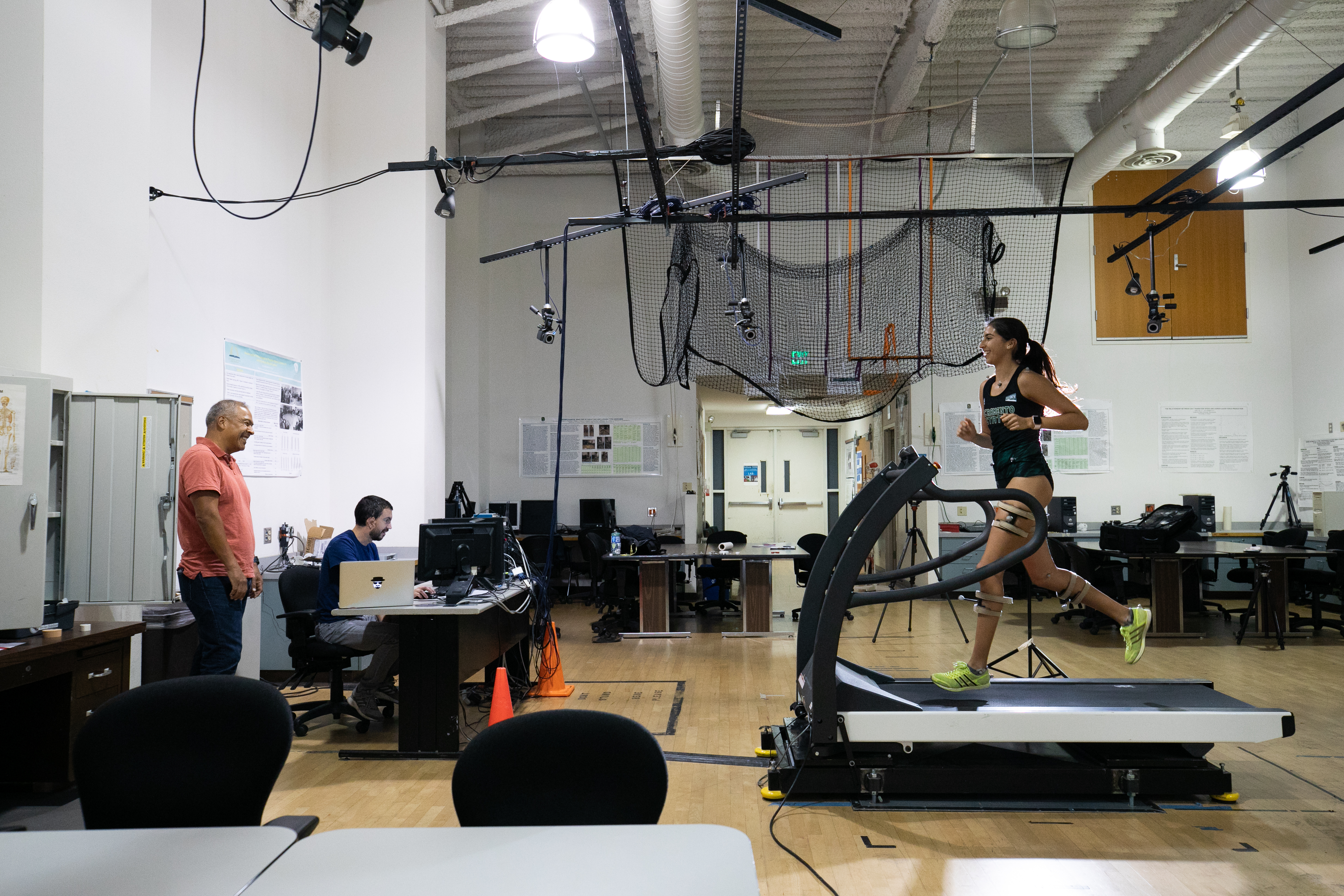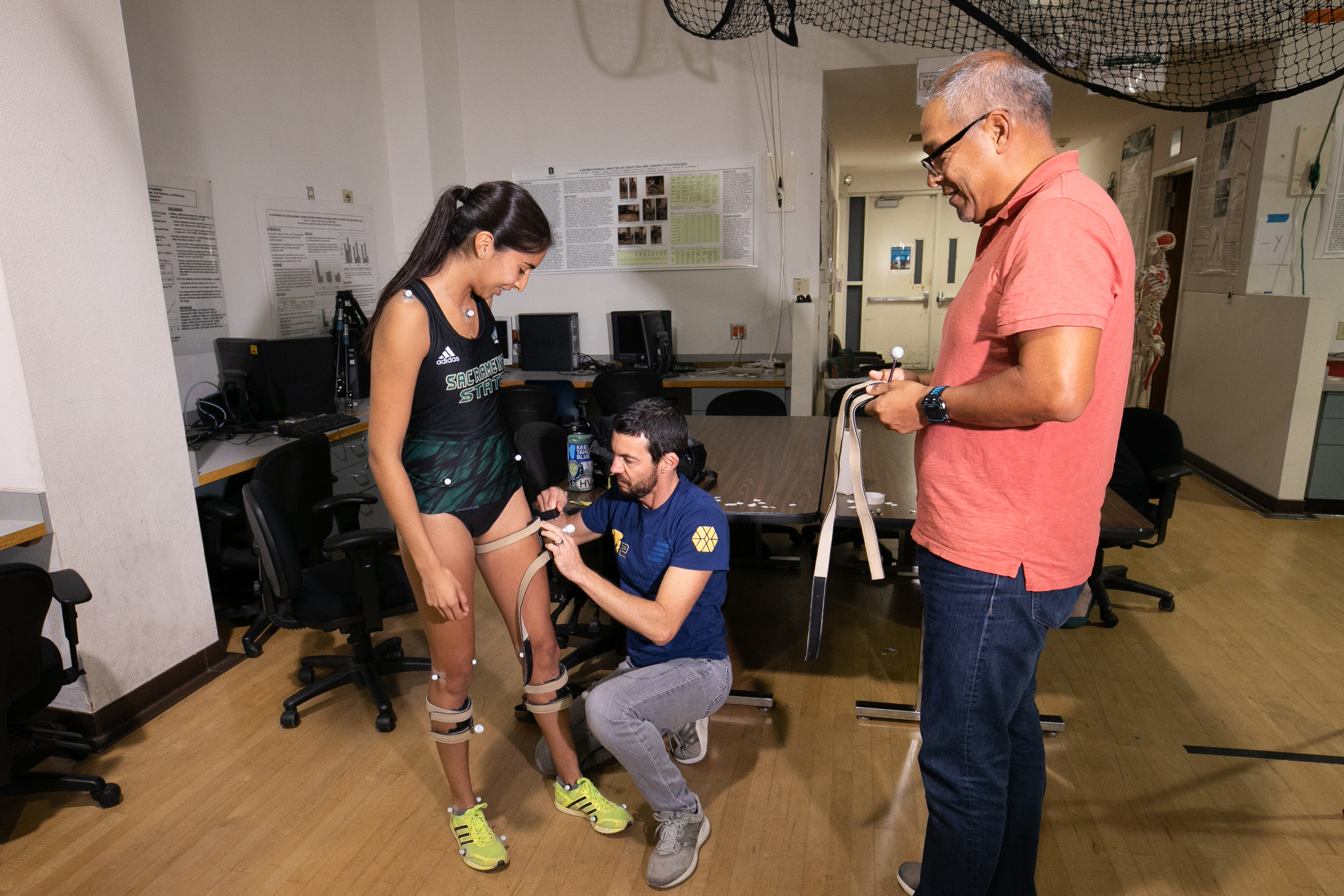 Amy Quinones, right, a distance runner on the Sac State track team, takes part in a new study of elite female runners underway at Sac State. Paolo Taboga, seated, and Roberto Quintana, professors of kinesiology, are leading the research project. (Sacramento State/Andrea Price)
Amy Quinones, right, a distance runner on the Sac State track team, takes part in a new study of elite female runners underway at Sac State. Paolo Taboga, seated, and Roberto Quintana, professors of kinesiology, are leading the research project. (Sacramento State/Andrea Price)
By Dixie Reid
Last October in Vienna, Austria, legendary Kenyan long-distance runner Eliud Kipchoge attempted to do what once was considered unthinkable: run a marathon in 2 hours or less.
Half a world away in Sacramento, and well past midnight, Paolo Taboga was transfixed by the YouTube livestream that followed Kipchoge’s every footfall for 26.2 miles.
“I was literally jumping up and down in front of the TV during the last couple of kilometers when we knew he was going to make it,” said Taboga, assistant professor of kinesiology and director of Sacramento State’s Biomechanics Lab. “And then he ran even faster at the end.”
 Professdor Paolo Taboga, kneeling, prepares Sac State distance runner Amy Quinones for testing. Professor Roberto Quintana assists. (Sacramento State/Andrea Price)
Professdor Paolo Taboga, kneeling, prepares Sac State distance runner Amy Quinones for testing. Professor Roberto Quintana assists. (Sacramento State/Andrea Price)Kipchoge, 34, ran the Vienna road course in 1 hour, 59 minutes, 40 seconds, making history and finishing faster than the marathon world record of 2:01:39 he set at the 2018 Berlin Marathon.
In 2014, the world record was 2:02:57.
“Dropping 3 minutes from that time was something crazy,” Taboga said. “Runners were usually able to lower the marathon world record by a few seconds every couple of years. It took 16 years to go from 2:06:05 to 2:02:57.
“So when INEOS (a multinational chemicals company) announced a new attempt this year, the 1:59 Challenge, all running fans were super excited, because we knew that the goal was possible – not easy by any means, but possible.”
The 1:59 Challenge that Kipchoge ran in Vienna was not a sanctioned race, so his time isn’t an official world record. That doesn’t matter to Taboga, a runner and champion of runners who was part of the research team that forecast Kipchoge’s sub 2-hour marathon.
“The proof was that humans actually can do it, and he did it by quite a margin – 20 seconds under – even though it was a closed circuit on an almost-ideal road with the right conditions, the right shoes,” Taboga said. “Who knows? Maybe he could have gone faster. Even five or six years ago, this was not even thinkable.”
Taboga collaborated with former colleagues at the University of Colorado, Boulder, where he was a postdoctoral fellow, on a biomechanics model to predict how much time a runner loses on curves as compared to running in a straight line.
They used that model and others to study the Vienna road course and predict how its hills would affect a runner’s speed. Three of the researchers, although not Taboga, served as consultants to the race organizers.
“The cool part is that we analyzed the course before Kipchoge ran,” Taboga said. “We predicted that, compared to an ideal straight-line course with a net downhill, he would lose less than 5 seconds.
“Kipchoge ended up running well under the 2-hour barrier,” Taboga said, “but the result was not granted: Two years ago, on a previous attempt on a different course, he ran 2:00:25, so every single second – and every curve and uphill and downhill – counted.”
Taboga came to Sac State in 2016 as an assistant professor in the Department of Kinesiology, within the College of Health & Human Services. He became the Biomechanics Lab’s director the following year.
He grew up in Italy and is a former competitive sprinter who now favors 5- and 10-kilometer races and the occasional half-marathon. A marathon, he says, “is too far for me.” He’s a member of the local Buffalo Chips Running Club and each December guides a visually impaired runner for a part of the California International Marathon.
Taboga earned his doctorate in Biomedical and Biotechnological Sciences from Italy’s University of Udine. His thesis explored the influence of body mass and the use of running-specific prostheses.
Since coming to Sacramento State, he has analyzed and published data from the study of amputee runners – to determine the optimal height and stiffness of prostheses – he did at the University of Colorado.
In addition, he and Roberto Quintana, a fellow professor of Kinesiology and the director of the University’s Human Performance Research Laboratory, have launched a research study of the physiological and biomechanical characteristics of elite female runners.
“We’re recruiting Olympic-quality runners to come to Sacramento State,” Taboga said. “We want to see if there are differences between elite athletes and recreational runners, if we can spot what’s different between someone who is good and someone who is really good. And then, what do you need to get better and faster?”
Volunteers are undergoing a running analysis in the Biomechanics Lab. The first volunteer was Olympian Kim Conley, who sometimes trains on the American River Parkway, near Sac State.
Weeks after Kipchoge's sub 2-hour marathon, Taboga is still exhilarated by the achievement and said he thinks someone eventually will post an even faster time.
"Shortly after Roger Bannister ran the first sub 4-minute mile, a time that was historic in 1954, a lot of runners went under that barrier. Now the record is 3:43.13, almost 17 seconds faster," Taboga said. "Will the same happen for the marathon? Probably. There was a mental barrier to overcome for runners at the start line: run a 4:34-per-mile pace. Now that barrier is gone, and athletes and coaches know it is possible that humans can run that fast for 26.2 miles – and they can probably run faster.
"The half-marathon world record is 58:01. Could an exceptional runner keep that pace for a whole marathon and finish in 1 hour, 56 minutes? Not now, probably not in the next four or five years, but who knows? As Eliud Kipchoge says: 'No human is limited.' "
